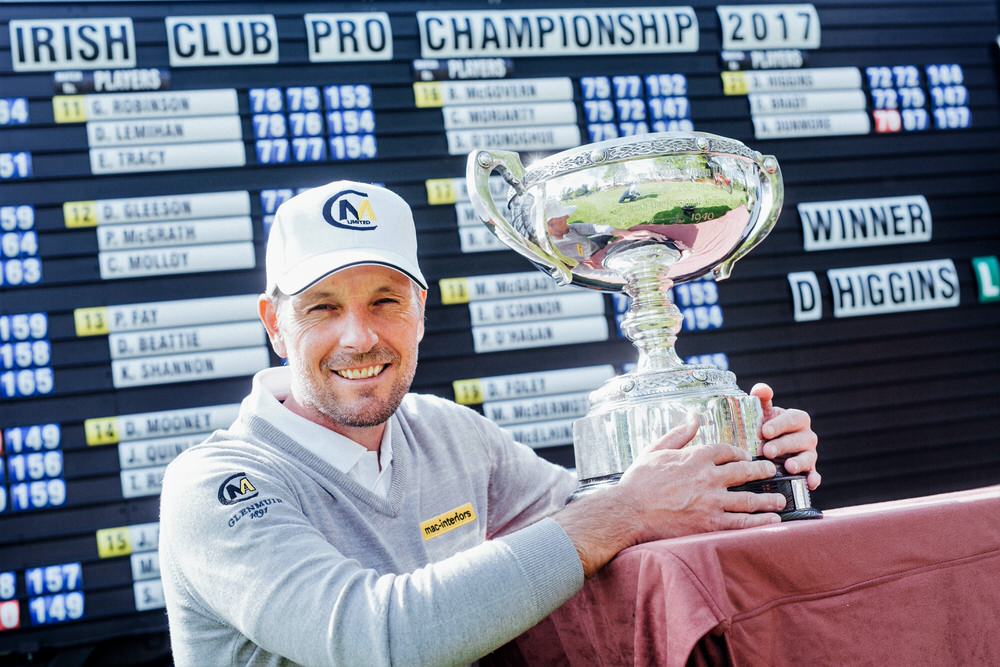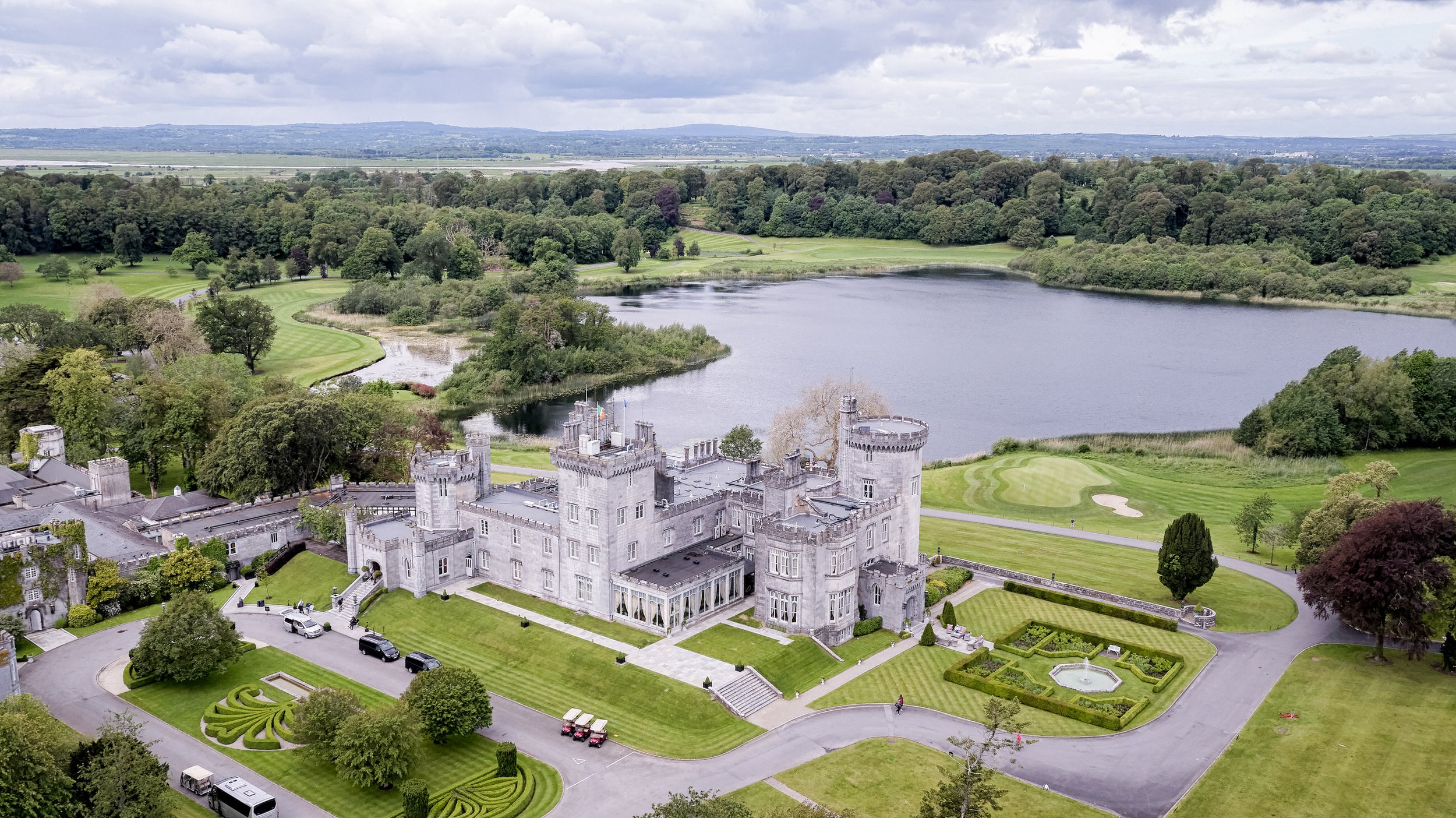Dromoland Castle — a resort fit for a king (or queen)

Dromoland Castle at dusk
It’s a place steeped in Irish history, a verdant paradise that’s hosted kings and Heads of State, sporting nobility, stars of screen and stage and industrial powerhouses. It’s also a course that’s far more worthy of your attention than you may have first thought.
From United States Presidents George W. Bush and Bill Clinton to king Juan Carlos I of Spain, Nelson Mandela and Muhammad Ali, Dromoland Castle has made them all feel at home, as befits one of the leading five star hotels of the world.
Yet it’s golf that concerns us here rather than the sumptuous luxury of the Neo-gothic castle with its bristling towers echoing the footsteps of the ancient O’Brien clan, descendants of Brian Bórú, High King of Ireland.
Leave aside for a moment the oak paneling, the crystal chandeliers, the luxuriant four-poster beds, the idyllic lake views of this small piece of paradise on earth in Newmarket-on-Fergus, Co Clare and focus for a moment on one of Ireland’s most under-rated golf courses.
Like everything else at Dromoland Castle, where you can dine in the Michelin-starred Earl of Thomond Restaurant, fish the lakes or simply pamper yourself in the spa after a relaxing walk in the leafy woodlands nearby, golf at Dromoland Castle Golf & Country Club is a five star experience.
The hotel bought back the Clare Inn a few years ago and it is now known as the Inn at Dromoland and while it is affordable for mortals like me, it’s comforts would put many a five-star hotel to shame.
The 11th green
The food in its restaurant and its popular gastro-pub, Shannigans, is top class while many of the rooms have undergone upgrades recently, making it an ideal place for that golfing weekend away or a home base from visits to the Burren or west Clare, where the Cliffs of Moher, Lahinch and Doonbeg await.
As for the golf course, nothing but the best was employed in the creation of this par-72 parkland gem, recreated from the skeleton of the original course built by American golf architect Brook L. Wigginton in 1961. It all happened some 13 years ago thanks to architect Ron Kirby and Irish golfing legend J.B. Carr.
Set on 360 acres of verdant rolling hills covered with lakes, streams, and centuries-old trees, Dromoland is one of Kirby’s prize creations and he’s designed a few in his time.
A graduate of the University of Massachusetts-Stockbridge, he launched his career in golf course architecture by accepting the position of design associate with Dick Wilson in 1958 before being lured away in 1963 by the great Robert Trent Jones Snr.
For next eight years, Kirby served under Jones as a design associate on a number of golf course projects located in the United States, Europe and the Caribbean before founding his own design firm. In conjunction with Gary Player, he worked all over the globe for the next 17 years, creating the Sun City Resort in Bophuthatswana and many other noted courses before selling his firm to Golden Bear Inc in 1986 and joining Jack Nicklaus Design Services.
One of the sumptuous rooms in Dromoland Castle
Responsible for overseeing Nicklaus’ entire inventory of European projects, Kirby went on to create Gleneagles Hotel & Resort in Scotland; Paris International Golf Club in France, the London Club in England, Mount Juliet in Co Kilkenny and the much-praised Old Head Golf Links in Kinsale, Co Cork.
But he will always have a special place in his heart for Dromoland, where we first met in 2003 as he sat in the hotel bar overlooking the 18th green and told a story that should not be taken as best practice for budding architects.
Bad golf courses look as if they were designed someone who has spent too long in the bar. But Ron joked that he went a step further and designed the 18th hole at Dromoland Castle from the bar itself.
A sprightly 73-year old at the time, he was justifiably proud as he looked out over his new creation having just transformed the tired 18 hole course that had been created more than 40 years previously and transformed it, with the help of the legendary Carr, into a track to rival Mount Juliet and the Old Head.
The academy is floodlit
For a man used to arguing golf with the Golden Bear himself, nobody was unduly surprised that Kirby succeeded in brilliantly transforming the original course into a world class, 6,810-yard championship test.
"We've got great potential here," Kirby boomed. "This could be as good as Gleneagles, the Kings or the Queens course, whatever. We've got the lake, the Castle and good ground. It's just terrific."
The proof of the pudding is in the eating and anyone who has played Dromoland Castle in the intervening decade will attest to that. In the past, the course was simply ignored by the golfing purists who stayed at the hotel on their way to the greats links of the south west.
Now, it is tough to get the golfing guests to leave the grounds. Centred around a spectacular lake and mature forest, the course features testing one-shotters — the downhill seventh is a classic — some clever short par fours such as the ninth and 10th, and a couple of muscular par fives (the 11th is arguably the best hole in the course) that will tame even the biggest hitters.
The 580 yard 18th stands out for its terrifying carry over the corner of the lake, leaving over 240 yards to a giant sequoia tree that guards a fiendishly contoured green that Kirby designed from the comfort of the Castle's tower bar.
The Fig Tree restaurant in the golf clubhouse
"The girl who runs the bar was laughing and I was complaining that the windows were dirty," he joked at the time. "But I've been here for over two years and this is going to be something special."
The jury is still out over the presence of the tree but it’s still a fine finish to what is a hugely enjoyable, if challenging, game of golf where resident PGA professional David Foley is on hand to teach you the finer points of the game at the club’s state of the art dry
Kirby began his career with a Francis Ouimet scholarship and studied agronomy. He ended up building greens in Florida because he couldn't get a job cutting them during the hard winter months in his native Massachusetts.
"I learned course routing from Trent Jones and strategy from Jack Nicklaus," he said. "Nicklaus is the finishing school of strategy. He is so intense when he gets on the course he is designing that he has been mad at me plenty of times but he's a good buddy still."
After running his own design company during the 1970s and 80s, when he built courses all over the world from the Ivory Coast and Japan to the Philippines and Scotland, Kirby took up a job offer from Nicklaus in 1986.
The Bear was about to open a European office and had just been offered the project at Mount Juliet in Kilkenny, the venue for the American Express World Golf Championship in 2002 and 2003.
A room in the Inn at Dromoland
While Mount Juliet will always be known as a Jack Nicklaus design, Kirby was responsible for discovering the spectacular canyon holes that give the front nine so much character.
Dromoland is not a Nicklaus course, but it bears all the hallmarks of the great man from the point of view of strategy.
The signature seventh stands high above a postage stamp sized green with water left and a shamrock bunker to the right. The 323-yard ninth is a par four to rival the Belfry's 10th, where the big hitters will be tempted to go straight for the water-protected green.
And the par five 11th, which curves around the lake, offers a chance to try for the green in two if you are brave enough to take the tiger line and cut off as much of the marshland as you dare.
The par-five finishing hole is another spectacular sight where you can make out the castle in the distance, 580 yards away.
"I could add on 200 yards to the layout but it's not designed for a major championship," Kirby explained. "This is a transition from a ho-hum course to a spectacular course. I think Jack would approve."











